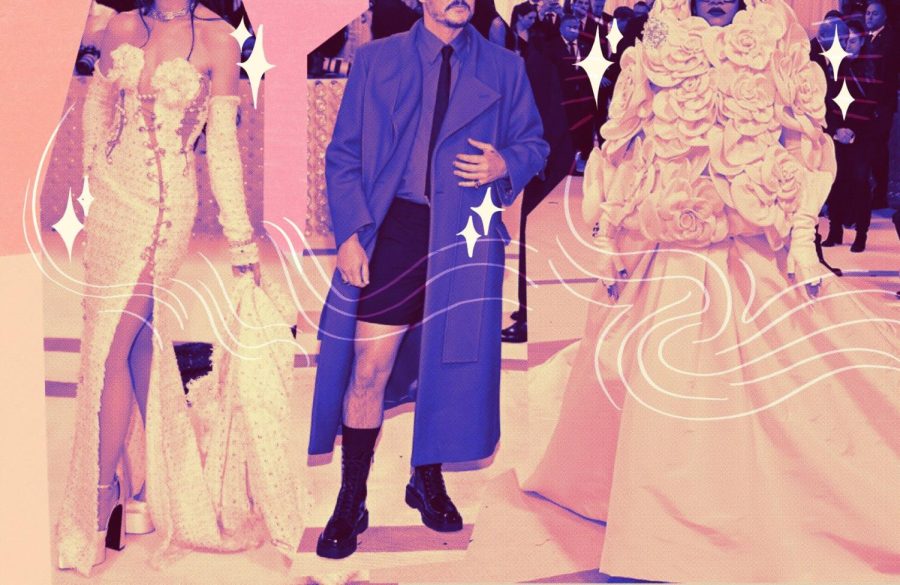Grotesque glamor: The problem with the Met Gala
Celebrities dressed in the most outrageous, extravagant displays of wealth for the 2023 Met Gala. This year’s dress code was “in honor of Karl,” referencing Karl Lagerfeld, most known for being the creative director of Chanel and Fendi, who passed away in 2019.
Coco Chanel was a Nazi, and Karl Lagerfeld was a xenophobic, fatphobic and all around very problematic person. Despite all of his past racism and sexism, every celebrity in attendance had nothing but good things to say about Lagerfeld.
The event was hosted by Vogue’s Editor-in-Chief Anna Wintour and is a charity fundraising event for the Metropolitan Museum of Art’s Costume Institute. This year the Costume Institute had an exhibition named “Karl Lagerfeld: A Line of Beauty,” celebrating his life and his artistry.
The same people on Twitter who were chanting “eat the rich” not too long ago were fawning over the outrageous looks celebrities were putting out.
I love fashion with all of my heart, and it would be ignorant of me to ignore the impact that Lagerfeld has had on the Western fashion industry. His sophisticated style completely revamped Chanel as a brand, and I would be lying if I said I didn’t admire his artistry or his designs.
There is something to be said for separating the art from the artist, but appreciating Lagerfeld’s art is one thing and honoring him at the largest public gala in the world is another.
The Met Gala has long held a reputation for its exclusivity. Most celebrities are invited to the gala with designers, but those that want to purchase their own ticket can fetch it for the low, low price of $50,000, with an invitation, of course.
Actress Jameela Jamil, known for her role in “The Good Place,” expressed her disappointment towards all the celebrities that attended this year’s Met Gala and called out the double standards in “cancel culture,” since those in attendance chose to conveniently forget the horrible comments Lagerfeld made, especially to those that spoke out during the “#MeToo” movement.
On Twitter, people theorized that those that wore pink to the event were secretly protesting against Lagerfeld, since he was known for disliking the color. This is not entirely true, since Lagerfeld had pink designs of his own and was known for contradicting himself and saying inflammatory things for attention.
Even if Lagerfeld truly hated the color pink, none of the celebrities that wore pink had anything negative to say about Lagerfeld. In fact, based on the testimony from people like Bella Hadid and Lily-Rose Depp, Lagerfeld was an incredible person.
For the past couple of years, there have been protests outside the Met Gala. One year, there was a Black Lives Matter protest and another year, there was a “Tax the rich” protest. Seeing the juxtaposition of not only the protesters versus the celebrities, but those who cannot afford housing in New York, let alone a dress costing tens of thousands of dollars.
Brands like Cartier and Tiffany also loan their most expensive jewelry to these celebrities, usually featuring blood diamonds that were stolen from colonized countries. Seeing diamonds mined by exploited African workers stolen from royals from my motherland on the necks of privileged white celebrities feels like a slap in the face. People like Emma Chamberlain seem oblivious to the history they are wearing, and the brands that loan them these multi-million dollar pieces will never return their jewelry to the countries they were mined in or stolen from.
The Met Gala continues to receive wide publicity, and I myself am guilty of looking through all the fashion and passing my own judgment on it. As the wealth gap continues to grow and the top 1% continues to hoard more wealth, it is important to be cautious of what we give a platform to.
The Met Gala raised more than $17 million last year, with millions more put towards the fashion at the event. Even a fraction of that money could improve so many lives for the better. It is the duty of the ultra-wealthy to use their privilege to contribute to society in more meaningful ways than funding a costume exhibit.







